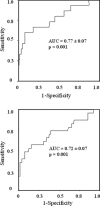Fragmented QRS in prediction of cardiac deaths and heart failure hospitalizations after myocardial infarction
- PMID: 20522053
- PMCID: PMC6932707
- DOI: 10.1111/j.1542-474X.2010.00353.x
Fragmented QRS in prediction of cardiac deaths and heart failure hospitalizations after myocardial infarction
Abstract
Background: Increased QRS fragmentation in visual inspection of 12-lead ECG has shown association with cardiac events in postmyocardial infarction (MI) patients. We investigated user-independent computerized intra-QRS fragmentation analysis in prediction of cardiac deaths and heart failure (HF) hospitalizations after MI.
Methods: Patients (n = 158) with recent MI and reduced left ventricular ejection fraction (LVEF) were studied. A 120-lead body surface potential mapping was performed at hospital discharge. Intra-QRS fragmentation was computed as the number of extrema (fragmentation index FI) in QRS. QRS duration (QRSd) was computed for comparison.
Results: During a mean follow-up of 50 months 15 patients suffered cardiac death and 23 were hospitalized for HF. Using the mean + 1 SD as cut-point both parameters were univariate predictors of both end-points. In multivariate analysis including age, gender, LVEF, previous MI, bundle branch block, atrial fibrillation, and diabetes FI was an independent predictor for cardiac deaths (HR 8.7, CI 3.0-25.6) and HF hospitalizations (HR 3.8, CI 1.6-9.3) whereas QRSd only predicted HF hospitalizations (HR 4.6, CI 2.0-10.7). In comparison to QRSd, FI showed better positive (PPA) and equal negative (NPA) predictive accuracy for both end-points, and PPA was further improved when combined to LVEF < 40%. Limiting fragmentation analysis to 12-lead ECG or a randomly selected 8-lead set instead of all 120 leads resulted in an almost similar prediction.
Conclusions: Increased QRS fragmentation in post-MI patients predicts cardiac deaths and HF progression. A computer-based fragmentation analysis is a stronger predictor than QRSd.
Figures




References
-
- Torabi A, Cleland JGF, Khan NK, et al The timing of development and subsequent clinical course of heart failure after a myocardial infarction. Eur Heart J 2008;29:859–870. - PubMed
-
- Lewis EF, Velazques EJ, Solomon SD, et al Predictors of the first heart failure hospitalization in patients who are stable survivors of myocardial infarction complicated by pulmonary congestion and/or left ventricular dysfunction: A VALIANT study. Eur Heart J 2008;29:748–756. - PubMed
-
- The SOLVD Investigators . Effect of enalapril on survival of patients with reduced left ventricular ejection fractions and congestive heart failure. N Engl J Med 1991;325:293–302. - PubMed
-
- Bristow MR, Saxon LA, Boehmer J, et al Cardiac‐Resynchronization therapy with or without an implantable defibrillator in advanced chronic heart failure. N Engl J Med 2004;350:2140–2150. - PubMed
Publication types
MeSH terms
LinkOut - more resources
Full Text Sources
Other Literature Sources
Medical
Research Materials
Miscellaneous

